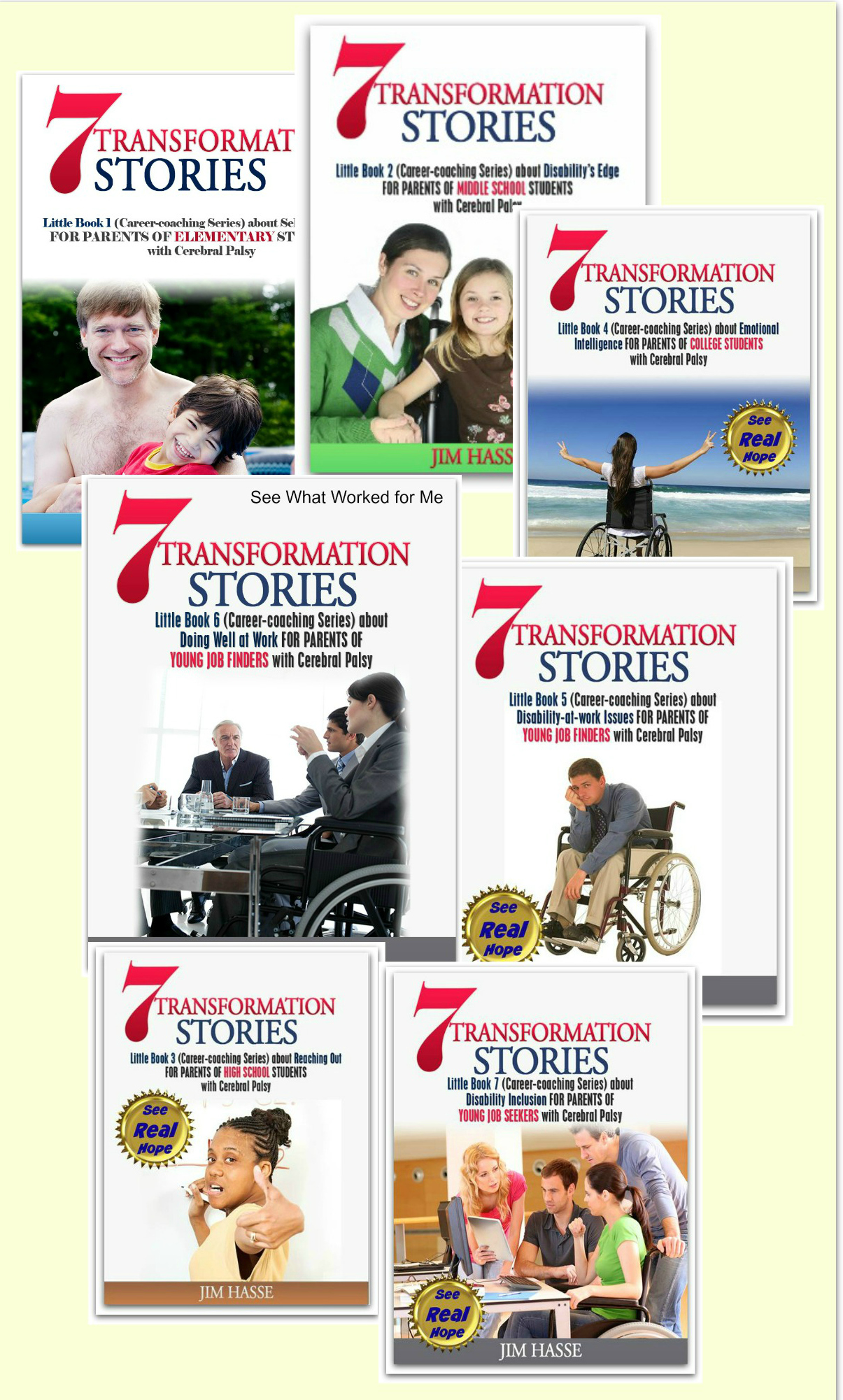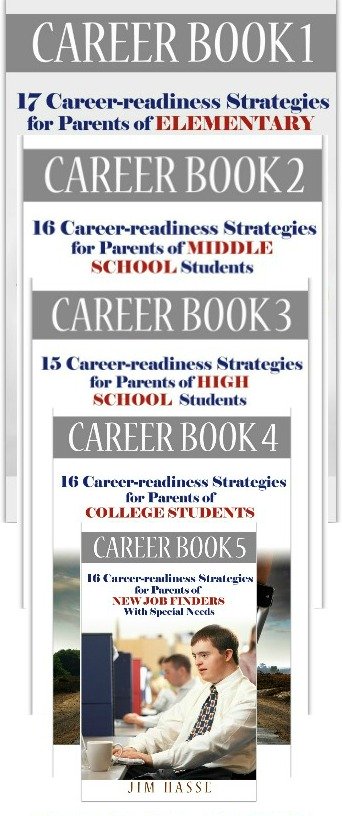Problem Solving Skills: Cerebral Palsy Career Builder for High School Students
By Jim Hasse, ABC, GCDF, Disability Employment Expert
_________________________________________________________
The demand for problem solving skills currently outstrips supply in today’s job market. That’s good news for your high school student with cerebral palsy (CP) because I don’t see that situation changing any time soon.
High school is the right time for your youngster to look at the current needs of the job market and to plan how he or she can personally turn those unmet needs, particularly the gap between need and availability of problem solving skills, into opportunities as an eventual job seeker.
Time-tested attributes
Informed recruiters within many of our nation’s leading companies know the following statement to be true.
Employees
with disabilities who are effectively recruited, trained and promoted bring to
workplace teams these qualities:
- Reduced
missed days of work.
- Lower
turnover.
- Increased
awareness of and appreciation for unique customer needs.
- Proven
problem-solving skills.
Together, these attributes add up to increased productivity, the real bottom-line benefit of including individuals with disabilities in our nation’s workforce. It means that employers with the savvy to find talented job seekers with disabilities who can show work results based on these high-in-demand but often low-in-supply personal qualities will likely be the most successful in the years to come.
But, let’s not stop there.

The new reality
Your high school student with CP needs to recognize that today’s employers are facing at least three new recruiting problems, according to John Liptak, Ed.D., Associate Director Career Services, Radford University, Radford, VA.
Here’s how Liptak describes these
recruiting challenges:
- Employers
are unable to fill vacant jobs.
- Employers
are not able to hire workers with the required skills.
- Jobs are changing so quickly that workers need basic skills for a variety of tasks.
Why are jobs going unfilled?
Liptak has been studying the survival and success rate of people entering the workforce since 2006. He says the U.S. workplace is still in a transition from what he calls the “traditional” model to a “high performance” model. The “employability” skills required for this new work environment have changed as a result, but our educational system is not fully preparing future jobseekers for those changes.
In May of 1990, a U.S. Department of Labor committee launched a comprehensive study about how well schools prepare young people for the workforce. Titled the Secretary's Commission on Achieving Necessary Skills (SCANS), this extensive work gave American business, for the first time, a platform to clearly communicate to educators what students need to know in order to be successful in the workplace.
The SCANS Report concluded that "… more than 50 percent of our young people leave school without the knowledge or foundation required to find and hold a good job."
Obviously, that caused quite a stir in education because school boards, administrators, and teachers realized our nation's students were not learning what they needed to know in order to be prepared for the workforce of the 21st century.
This problem, the report said, stems from the fact that today’s working environment, focused on information, service, and communication, is vastly different than the industrial workplace of the early 1900s – due, in part, to advances in technology and competition from countries abroad.
The
report called for a whole new approach to education, involving a switch from
basic-skill learning to development of thinking skills and problem solving
skills.
In fact, shortly after its release, the SANS Report prompted 45 states to adopt Common Core State Standards,
the educational approach for overhauling classroom instruction. Common Core
State Standards emphasize critical thinking and problem solving and are meant
to better prepare students for success.
Yesterday’s traditional workplaces were centrally controlled and marked by mass production and fragmented tasks performed by employees who had minimal qualifications and training and who were encouraged to “specialize” in their careers. Advancement was by seniority.
Today’s high-performance work environment is characterized by flexible production, decentralized control, work teams, and multi-skilled workers. Training is available to anyone, and advancement is based on certification of skill sets.
In short, today’s employers are seeking employees with thinking skills and individuals who work well with others (and learn with others) so they can use their problem solving skills to effectively address a series of issues on a variety of projects.
And,
increasingly, individuals find themselves “hiring out” their problem solving skills
on a contractual basis to a variety of “employers” in a labor market consisting of "temporary employment" opportunities.
Liptak observes that there are still “deficits” in thinking skills, resource management, information skills, interpersonal skills and systems management – all what the SANS Report calls “employability skills” (skills which are not technical but which cut horizontally across all industries and vertically across all jobs).
One example of an employability skill is the ability to work cooperatively with others to solve real issues.
When did you realize
that living with a disability can nurture
a problem-solving skill in your youngster?
Join
PACER’s Facebook
discussion.
Filling the void
Anytime I see a gap between need and capability in the general labor force, I see opportunities for future job seekers such as your youngster who are fully prepared to fill that void.
For employers, I also see an opportunity to fill that void by recruiting talented, prepared individuals with disabilities, a largely untapped resource with only 37 percent of working-age adults with disabilities participating in the labor force (according to the U.S. Bureau of Labor Statistics).
And, for some occupations, this gap is being filled by savvy, talented individuals with disabilities. For example, the employment rate for scientists and engineers with disabilities is 83 percent, much better than the estimated 37 percent for the overall U.S. population with disabilities, according to the American Association for the Advancement of Science.
In fact, pursuing a STEM career (such as process engineer, which uses knowledge of science, technology, electronics and math in integrated ways) is well worth the effort. It fits the new paradigm of multi-skilled employees who work under decentralized authority and who can transfer their problem solving skills among a variety of occupations and industries.
Process engineering jobs, by the way, often go unfilled due to lack of qualified applicants.
If there are jobs open because there are not enough people qualified with the new “employability skills” to fill them, those are the jobs for which I would prepare and seek – particularly because, as a person with CP, I have learned how to effectively manage my disability by working with others. And I know how to transfer those attributes to on-the-job situations.
Look
at a few of the key skill deficits Liptak says he still finds in individuals
entering the workforce.
I’ll give you examples of how your youngster with CP can eventually cite
work/volunteer/care management experience for turning those nation-wide
deficits into personal competitive advantages he or she can use to get hired.
Thinking
Skills – “I creatively came up with technology-based
solutions to address my walking and
talking disabilities by visualizing preferred outcomes, learning about the
options I had and carrying
out the steps needed to realize those outcomes.”
Personal Qualities – “I have effectively managed a series of paid personal assistants during the last five years with integrity and authenticity through honest, open communication.”
Resource Management – “I managed time, money and materials in a six-month advocacy effort for people with disabilities who were in need of local transportation services.”
Technology Use – “I chaired a committee which studied and recommended note-taking options to add as a disabled student service at a local, private college.”
Notice these so-called new employability skills are competencies that stem from the four productivity attributes I first listed above. These competencies have already been proven, though decades of study, to be competencies an employer gains by hiring individuals with disabilities.
So, what was true in the last century is even more so in the 21st. A strong workforce includes individuals who have acquired problem solving skills by learning how to live well with disability.
It’s a personal marketing approach your youngster can eventually use in seeking a job. In using that approach, he or she will be acknowledging the gap between the need and availability of key employability skills (such as problem solving skills) and adding those competencies to his or her portfolio.
I see no better strategy for positioning oneself as a valued job candidate.
When did you realize
that living with a disability can nurture
a problem-solving skill in your youngster?
Join
PACER’s Facebook
discussion.
Return
from Problem Solving Skills to Part-time Jobs
Go
to Cerebral Palsy Career Builders
This is Creative Commons content. You can freely and legally use, share and repurpose it for non-commercial purposes only, provided you attach this sentence and the following attribution to it (including the two links):
Originally written and illustrated by Jim Hasse, ABC, GCDF, owner of Hasse Communication Counseling, LLC, who, as a person with cerebral palsy, served for 10 years as a vice president in a Fortune 500 company during his 29-year career in corporate communication. He’s an Accredited Business Communicator, certified as a Global Career Development Facilitator and author of 14 Amazon books about disability awareness and disability employment issues.





